Numismatic Treasures #2: 1674/5 St. Patrick Coppers
 LeeG
Posts: 12,162 ✭
LeeG
Posts: 12,162 ✭
My first Numismatic Treasures thread discussed the 1793 Strawberry Leaf Cent. MidLifeCrisis posted this in that thread:
<< <i>Looking forward to a few posts on colonials! >>
>>
I figured, why not, let me give it a shot. So here is my attempt:
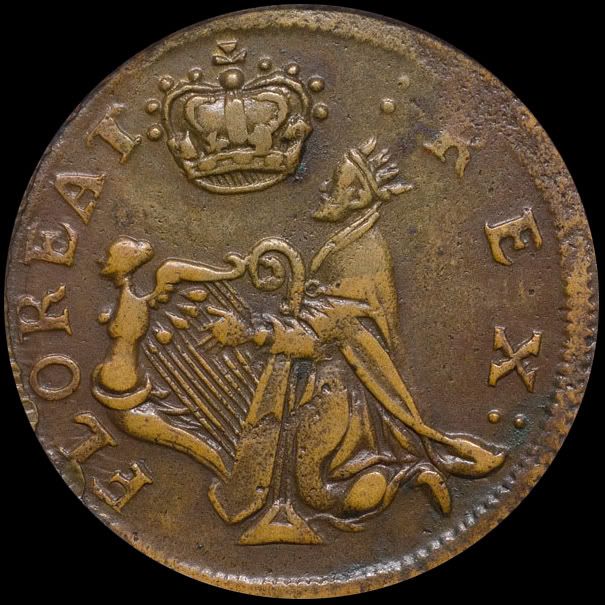
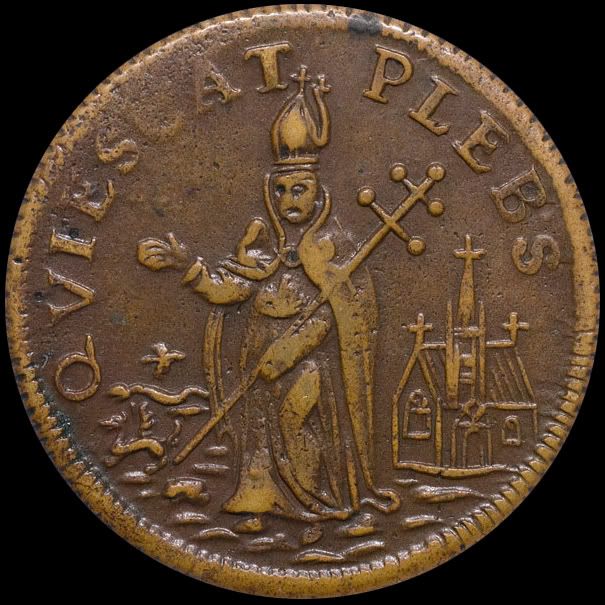
PCGS AU50, "The Collier Collection", ex Bowers' March 1988 sale of the Norweb Collection
As an early American Settler in the New World, it must have been a very confusing and difficult era. The land was divided into territories of various countries, each with their own languages, customs, and traditions. The settlers had to learn to survive in a new and sometimes hostile environment. They lacked many of the essentials, and one of the most important was a monetary system.
In the American Colonies, there were French coins, and Dutch coins, but a majority of the coins that circulated were English, Portuguese and Spanish. One thing was for sure all coins were very scarce. That is probably why the early settlers mostly used the monetary system of the Native Americans: bartering and wampum.
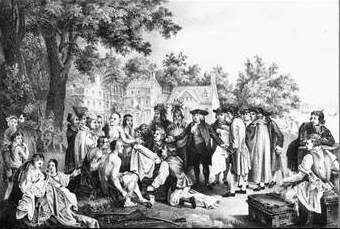
As a barter medium, wampum was a key interaction object between Euro-American settlers and the Native American culture. In the scene above, William Penn (center) is purchasing land from the Delaware tribe in 1682 that became the colony of Pennsylvania. As part of the payment, Penn provided wampum beads. Image courtesy of Library of Congress.
Originally minted for use in Ireland, St. Patrick coppers had a long and varied history. An English Quaker merchant in Dublin named Mark Newby (or Newbie) acquired a large supply of these coins which he took with him in 1681 when he emigrated to West New Jersey (New Jersey was divided into separate Eastern and Western colonies from 1676-1702). On May 18, 1682 the General Free Assembly of West New Jersey granted Newby's coppers legal tender status and allowed them to circulate as small change at the rate of a halfpenny, replacing wampum. The only restrictions were that Newby had to put up surety (300 acres of land) that he would exchange the coppers for "pay equivalent" on demand and that one was not required to accept more than five shillings in coppers at one time. When Newby died about a year later, in the fall of 1682, his estate included £30 in coppers, estimated at roughly 10,800 coins. Newby's St. Patrick coppers filled an important need in local commerce and remained in circulation throughout the colonial period. In fact, in 1881 the eminent New Jersey copper specialist Edward Marris stated that St. Patrick coppers continued to be found in change in western New Jersey into the early 19th century.
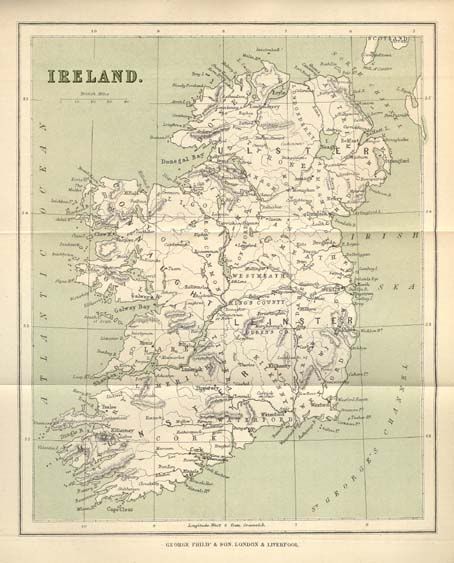
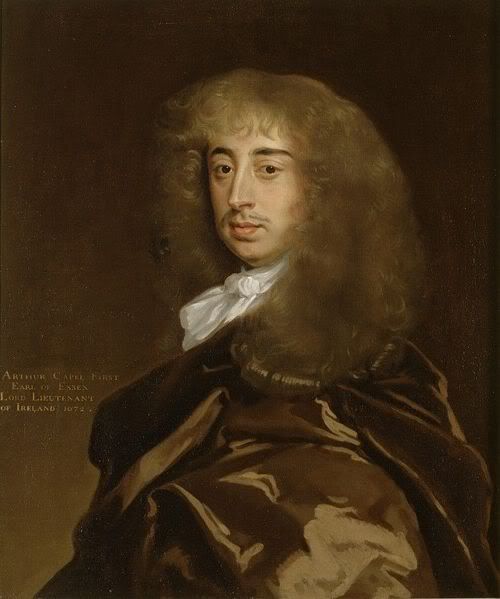
The 1st Earl of Essex, in a painting commemorating his appointment as Lord Lieutenant of Ireland, 1672.
Several theories have been put forth on the origins of the Saint Patrick coppers. The most plausible is that the tokens were minted in Dublin around the period 1674-1675. A single smaller size or "farthing" coin was found in a hoard of 273 coins recovered from the yacht Mary which sank on March 24, 1675, on its way from Dublin to Chester. From this it is certain the production of these coins date to at least 1675. Although there is no evidence as to how much earlier the coins were minted, it is suspected they were part of a coinage sanctioned by Arthur, Earl of Essex, who was the Lord Lieutenant of Ireland from 1672 to 1677. The connection to the Lord Lieutenant is suspected because these coins were carefully made with high quality standards. Each blank planchet had a drop of molten brass added to the obverse before striking. This served a dual purpose in that it made counterfeiting more difficult and gave a golden appearance to the royal English crown on the top of the coin. Also, during minting each coin was given a reeded edge to prevent clipping. Additionally, special presentation copies were made, for a few examples of the smaller size coins survive that were struck in silver or gold. Also, the coins had a royalist legend on the obverse (FLOREAT REX - May the king flourish). All of these facts suggest the coins were designed to have an official status and were not merely a private merchant issue.
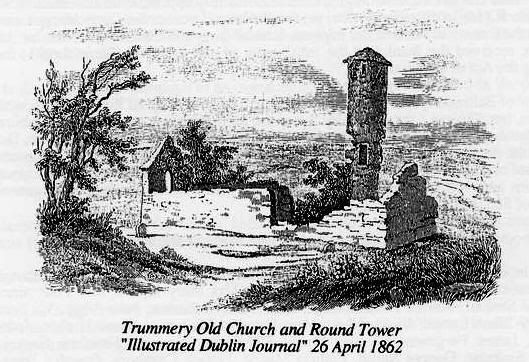
Saint Patrick coppers were issued in both large planchet and small planchet varieties, which numismatists have traditionally called a halfpenny and a farthing. Recently this terminology has come into question, for contemporary sources only mention halfpence. Philip Mossman has explored this question further by demonstrating the weight of the smaller coin was too heavy for the normal 2:1 ratio of halfpenny to farthing. He concluded that both coins were halfpenny tokens. Most probably, the larger and heavier coins (averaging about 135.7 grains) were produced earlier. These coins are found in only about ten varieties. In all there are about five obverse dies and six reverse dies used in nine or ten combinations. This suggests a rather brief minting period, that could at a maximum have only extend over the life of the five obverse dies. It also appears these dies were in simultaneous or at least overlapping use based on the obverse and reverse combinations listed by Vlack (both obverses 1 and 4 are found with reverse B and obverses 2, 3 and 4 share reverse C). Extrapolating from what we know about later colonial American minting operations such as the Massachusetts coppers, these eleven dies would have lasted no more than one year (at the Massachusetts mint in 1787 eleven dies were cut and used to make about 90,900 cents and in 1788 twenty five dies were produced to mint some 210,000 cents).
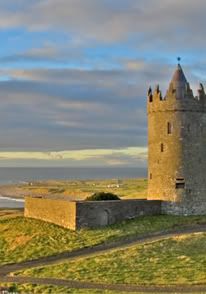

The Burren affordeth not a piece of timber sufficient to hang a man, water in any one place to drown a man, or earth enough in any one part to bury him. The Journal of Thomas Dinel.
The smaller planchet coin seem to have been much more extensively minted as over 120 die varieties exist! Such a massive die production would clearly have kept the mint in operation for at least two to three years. Not only were these smaller sized coins easier to mint but they were also more profitable. Mossman has calculated that based on the cost of operations and supplies the minting of the large planchet 135.7 grain halfpenny left the minters a profit of 49.1%. By switching to the smaller planchet 92.3 grain halfpenny minting profits were increased to 119.1%. No doubt the minter's enthusiasm for the smaller planchet coins led them to produce the gold and silver presentation copies of these coins for distribution to influential officials in return for their support of the weight and size reduction of the coin.
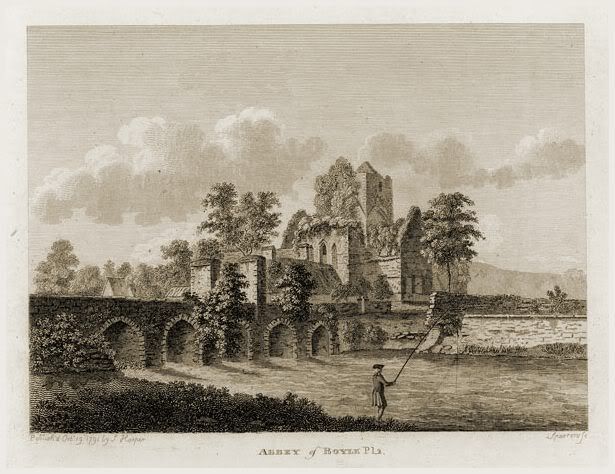
A large number of St. Patrick coppers were sent to the Isle of Mann where they were used as the standard currency during the minority of the Earl of Derby, hereditary lord of the island. When the earl became of age, the coins were demonetized by the act of Tynwald on June 24, 1679. Two years later in some unknown manner Mark Newby acquired a large supply of these coins in Dublin which he brought with him when he set sail for America from Dublin on the ship Owners Adventurer on September 19, 1681.
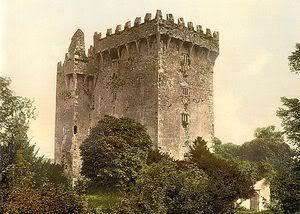
The problem for American colonial numismatics is we do not know exactly which kind of St. Patrick coppers Newby brought with him. It had long been thought only the large planchet coins were imported since the West New Jersey legislation spoke only of "halfpence" and until recently only the large planchet coins were considered to be halfpence. Also, in excavations of colonial sites only a few St. Patrick coppers have been found and they have been the larger planchet variety. However, according to Breen, a significant number of the smaller planchet St. Patrick coppers have been discovered in hoards with later 18th century coppers (Woods halfpence, Rosa Americana coppers and George II halfpence). Based on this evidence we can assume the smaller sized coin circulated in the colonies but we do not know for sure if they were part of Newby's 17th century supply or if they were brought over later in the 18th century.
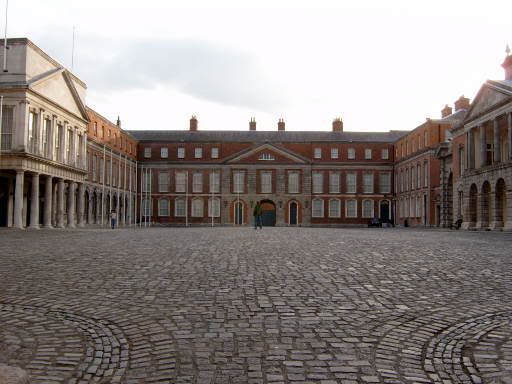
Dublin Castle
The obverse of both size coins show a kneeling King David (wearing what in heraldic terms is called an eastern crown) playing the harp as he looks up at the English crown with the legend FLOREAT REX (May the king flourish) above. The reverse of the larger coin shows Saint Patrick with miter and crozier blessing a congregation with a shamrock. Behind Patrick is the heraldic shield of the city of Dublin consisting of three castles (each pair of towers represents a castle). Above is the legend ECCE GREX (Behold the flock). The reverse of the smaller planchet coin shows Saint Patrick wearing a miter and holding a Metropolitan cross as he banishes various reptiles and serpents from the country. Behind him is a church. The legend reads: QUIESCAT PLEBS (Let the people be at ease).
References:
See: Walter Breen, "Comments on St. Patrick Halfpence and Farthings" The Colonial Newsletter 7 (April 1968, serial no. 22), 214-217; and his "Additional Comments on St. Patrick Farthings" The Colonial Newsletter 7 (December 1968, serial no. 24), 233; Michael Hodder, "The Saint Patrick Copper Token Coinage: A Re-evaluation of the Evidence, The Colonial Newsletter 27 (November 1987, serial no. 77), 1016-18; John Horan, "Some Observations and Speculations on St. Patrick Halfpence and Farthings," The Colonial Newsletter 15 (Oct. 1976, serial no. 47), 567; Eric Newman, "Circulation of St. Patrick Farthings in America, The Colonial Newsletter 7 (July 1968, serial no. 23), 220; Robert Vlack, "Die Varieties of St. Patrick Halfpence," The Colonial Newsletter 7 (January 1968, serial no. 21), 199-202.
<< <i>Looking forward to a few posts on colonials!
I figured, why not, let me give it a shot. So here is my attempt:


PCGS AU50, "The Collier Collection", ex Bowers' March 1988 sale of the Norweb Collection
As an early American Settler in the New World, it must have been a very confusing and difficult era. The land was divided into territories of various countries, each with their own languages, customs, and traditions. The settlers had to learn to survive in a new and sometimes hostile environment. They lacked many of the essentials, and one of the most important was a monetary system.
In the American Colonies, there were French coins, and Dutch coins, but a majority of the coins that circulated were English, Portuguese and Spanish. One thing was for sure all coins were very scarce. That is probably why the early settlers mostly used the monetary system of the Native Americans: bartering and wampum.

As a barter medium, wampum was a key interaction object between Euro-American settlers and the Native American culture. In the scene above, William Penn (center) is purchasing land from the Delaware tribe in 1682 that became the colony of Pennsylvania. As part of the payment, Penn provided wampum beads. Image courtesy of Library of Congress.
Originally minted for use in Ireland, St. Patrick coppers had a long and varied history. An English Quaker merchant in Dublin named Mark Newby (or Newbie) acquired a large supply of these coins which he took with him in 1681 when he emigrated to West New Jersey (New Jersey was divided into separate Eastern and Western colonies from 1676-1702). On May 18, 1682 the General Free Assembly of West New Jersey granted Newby's coppers legal tender status and allowed them to circulate as small change at the rate of a halfpenny, replacing wampum. The only restrictions were that Newby had to put up surety (300 acres of land) that he would exchange the coppers for "pay equivalent" on demand and that one was not required to accept more than five shillings in coppers at one time. When Newby died about a year later, in the fall of 1682, his estate included £30 in coppers, estimated at roughly 10,800 coins. Newby's St. Patrick coppers filled an important need in local commerce and remained in circulation throughout the colonial period. In fact, in 1881 the eminent New Jersey copper specialist Edward Marris stated that St. Patrick coppers continued to be found in change in western New Jersey into the early 19th century.


The 1st Earl of Essex, in a painting commemorating his appointment as Lord Lieutenant of Ireland, 1672.
Several theories have been put forth on the origins of the Saint Patrick coppers. The most plausible is that the tokens were minted in Dublin around the period 1674-1675. A single smaller size or "farthing" coin was found in a hoard of 273 coins recovered from the yacht Mary which sank on March 24, 1675, on its way from Dublin to Chester. From this it is certain the production of these coins date to at least 1675. Although there is no evidence as to how much earlier the coins were minted, it is suspected they were part of a coinage sanctioned by Arthur, Earl of Essex, who was the Lord Lieutenant of Ireland from 1672 to 1677. The connection to the Lord Lieutenant is suspected because these coins were carefully made with high quality standards. Each blank planchet had a drop of molten brass added to the obverse before striking. This served a dual purpose in that it made counterfeiting more difficult and gave a golden appearance to the royal English crown on the top of the coin. Also, during minting each coin was given a reeded edge to prevent clipping. Additionally, special presentation copies were made, for a few examples of the smaller size coins survive that were struck in silver or gold. Also, the coins had a royalist legend on the obverse (FLOREAT REX - May the king flourish). All of these facts suggest the coins were designed to have an official status and were not merely a private merchant issue.

Saint Patrick coppers were issued in both large planchet and small planchet varieties, which numismatists have traditionally called a halfpenny and a farthing. Recently this terminology has come into question, for contemporary sources only mention halfpence. Philip Mossman has explored this question further by demonstrating the weight of the smaller coin was too heavy for the normal 2:1 ratio of halfpenny to farthing. He concluded that both coins were halfpenny tokens. Most probably, the larger and heavier coins (averaging about 135.7 grains) were produced earlier. These coins are found in only about ten varieties. In all there are about five obverse dies and six reverse dies used in nine or ten combinations. This suggests a rather brief minting period, that could at a maximum have only extend over the life of the five obverse dies. It also appears these dies were in simultaneous or at least overlapping use based on the obverse and reverse combinations listed by Vlack (both obverses 1 and 4 are found with reverse B and obverses 2, 3 and 4 share reverse C). Extrapolating from what we know about later colonial American minting operations such as the Massachusetts coppers, these eleven dies would have lasted no more than one year (at the Massachusetts mint in 1787 eleven dies were cut and used to make about 90,900 cents and in 1788 twenty five dies were produced to mint some 210,000 cents).


The Burren affordeth not a piece of timber sufficient to hang a man, water in any one place to drown a man, or earth enough in any one part to bury him. The Journal of Thomas Dinel.
The smaller planchet coin seem to have been much more extensively minted as over 120 die varieties exist! Such a massive die production would clearly have kept the mint in operation for at least two to three years. Not only were these smaller sized coins easier to mint but they were also more profitable. Mossman has calculated that based on the cost of operations and supplies the minting of the large planchet 135.7 grain halfpenny left the minters a profit of 49.1%. By switching to the smaller planchet 92.3 grain halfpenny minting profits were increased to 119.1%. No doubt the minter's enthusiasm for the smaller planchet coins led them to produce the gold and silver presentation copies of these coins for distribution to influential officials in return for their support of the weight and size reduction of the coin.

A large number of St. Patrick coppers were sent to the Isle of Mann where they were used as the standard currency during the minority of the Earl of Derby, hereditary lord of the island. When the earl became of age, the coins were demonetized by the act of Tynwald on June 24, 1679. Two years later in some unknown manner Mark Newby acquired a large supply of these coins in Dublin which he brought with him when he set sail for America from Dublin on the ship Owners Adventurer on September 19, 1681.

The problem for American colonial numismatics is we do not know exactly which kind of St. Patrick coppers Newby brought with him. It had long been thought only the large planchet coins were imported since the West New Jersey legislation spoke only of "halfpence" and until recently only the large planchet coins were considered to be halfpence. Also, in excavations of colonial sites only a few St. Patrick coppers have been found and they have been the larger planchet variety. However, according to Breen, a significant number of the smaller planchet St. Patrick coppers have been discovered in hoards with later 18th century coppers (Woods halfpence, Rosa Americana coppers and George II halfpence). Based on this evidence we can assume the smaller sized coin circulated in the colonies but we do not know for sure if they were part of Newby's 17th century supply or if they were brought over later in the 18th century.

Dublin Castle
The obverse of both size coins show a kneeling King David (wearing what in heraldic terms is called an eastern crown) playing the harp as he looks up at the English crown with the legend FLOREAT REX (May the king flourish) above. The reverse of the larger coin shows Saint Patrick with miter and crozier blessing a congregation with a shamrock. Behind Patrick is the heraldic shield of the city of Dublin consisting of three castles (each pair of towers represents a castle). Above is the legend ECCE GREX (Behold the flock). The reverse of the smaller planchet coin shows Saint Patrick wearing a miter and holding a Metropolitan cross as he banishes various reptiles and serpents from the country. Behind him is a church. The legend reads: QUIESCAT PLEBS (Let the people be at ease).
References:
See: Walter Breen, "Comments on St. Patrick Halfpence and Farthings" The Colonial Newsletter 7 (April 1968, serial no. 22), 214-217; and his "Additional Comments on St. Patrick Farthings" The Colonial Newsletter 7 (December 1968, serial no. 24), 233; Michael Hodder, "The Saint Patrick Copper Token Coinage: A Re-evaluation of the Evidence, The Colonial Newsletter 27 (November 1987, serial no. 77), 1016-18; John Horan, "Some Observations and Speculations on St. Patrick Halfpence and Farthings," The Colonial Newsletter 15 (Oct. 1976, serial no. 47), 567; Eric Newman, "Circulation of St. Patrick Farthings in America, The Colonial Newsletter 7 (July 1968, serial no. 23), 220; Robert Vlack, "Die Varieties of St. Patrick Halfpence," The Colonial Newsletter 7 (January 1968, serial no. 21), 199-202.
1
Comments
God bless your little heart, Lee.
``https://ebay.us/m/KxolR5
I'm happy that you chose this coin as your first colonial Numismatic Treasures post...I think it's a very mysterious and interesting coin.
You, sir, are a credit to these boards!
That thread really makes me want to go to Ireland.......Like right now!!!!
Another excellent piece.
<< <i>Great post LeeG... but I at first I thought this was Russ!
How come his hair is so funny?
<< <i>Fantastic read, Lee! Thanks! >>
I am a metal detecting enthusiast from Southern New Jersey. My home is less than 10 miles from the land where Mark Newby resided. The Newby Coppers are on the top of my metal detecting list of coins to find, but I doubt I will ever dig one of these coins. I have some serious doubts on Marris' claim that these coins were widely circulated in this area well into the 19th century. In fact I have doubts that these coins were ever widely circulated in the colonies as claimed, for the following reason. Between myself and other serious "detectorists" in this area, we have dug thousands of colonial copper coins dating back to the mid seventeenth century. Out of these thousands of coppers I am only aware of one St. Patrick Halfpenny, and this was dug 10-15 years ago. Conversely, I see William III and William & Mary Halfpennies pop up fairly often. It would appear to me that the St. Patrick Coppers were legal tender on paper only, while the William Coppers circulated widely in West Jersey. Now the real question is What happened to the 14,400 coppers said to have been imported by Mr. Newby.
One day I hope to find out.
Oh by the way. Nice reprint. You should probably give credit to the author, Raymond F. Hanisco. I am sure he would be happy to see his article reprinted here.
njcc
zap
102 capped bust half dollars - 100 die marriages
BHNC #198
<< <i>Shameless
Lá Fhéile Pádraig ... get your livers ready
Collector since 1976. On the CU forums here since 2001.
<< <i>Too bad threads like this are not stickied. >>
Yes, I agree.
But I sold that Norweb St. Patrick, so seeing this particular thread makes me sad now.
Coin's for sale/trade.
Tom Pilitowski
US Rare Coin Investments
800-624-1870
<< <i>I remember, didn't mean to rub it in
No worries Fletcher. The sale allowed me to buy another cool coin.
Bumping an old but interesting thread. LeeG put a lot of work into it. I love these types of threads.
good call. there were a good amount of members that would do this stuff on the regular several years back.
I am American, but of Irish heritage, and I even have a fairly extensive Irish coin collection including “ring money” dug in Ireland and several Hiberno-Norse Pennies, and dozens of gunmoney pieces, but I don’t have one of these. Thank you for posting! I’ll get one soon!
Tom
I've got one of the small size pieces, often called a farthing. I wish I had gotten one of the larger or halfpenny pieces back when they were more affordable!